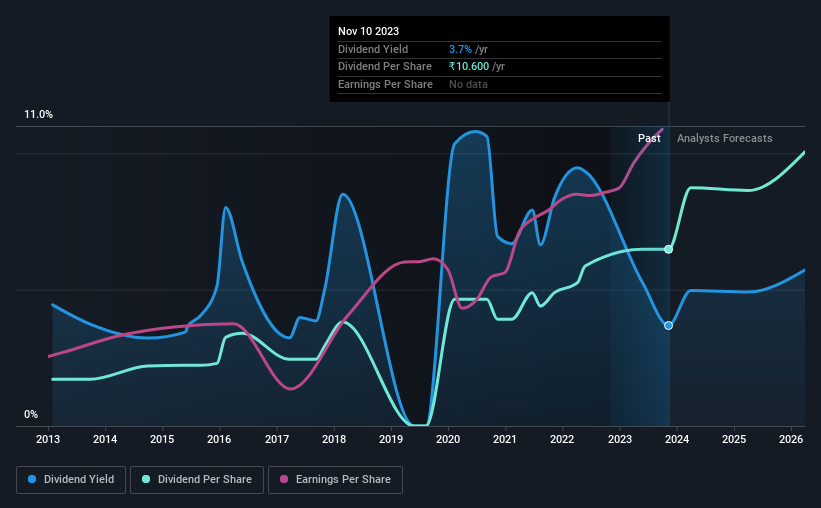- India
- /
- Diversified Financial
- /
- NSEI:PFC
Power Finance's (NSE:PFC) Upcoming Dividend Will Be Larger Than Last Year's

Power Finance Corporation Limited (NSE:PFC) has announced that it will be increasing its dividend from last year's comparable payment on the 8th of December to ₹4.50. This will take the annual payment to 3.7% of the stock price, which is above what most companies in the industry pay.
While the dividend yield is important for income investors, it is also important to consider any large share price moves, as this will generally outweigh any gains from distributions. Investors will be pleased to see that Power Finance's stock price has increased by 36% in the last 3 months, which is good for shareholders and can also explain a decrease in the dividend yield.
Check out our latest analysis for Power Finance
Power Finance's Earnings Easily Cover The Distributions
While it is great to have a strong dividend yield, we should also consider whether the payment is sustainable. Based on the last payment, Power Finance was earning enough to cover the dividend, but free cash flows weren't positive. With the company not bringing in any cash, paying out to shareholders is bound to become difficult at some point.
Looking forward, earnings per share is forecast to fall by 7.5% over the next year. Assuming the dividend continues along recent trends, we believe the payout ratio could be 27%, which we are pretty comfortable with and we think is feasible on an earnings basis.

Dividend Volatility
Although the company has a long dividend history, it has been cut at least once in the last 10 years. The dividend has gone from an annual total of ₹2.80 in 2013 to the most recent total annual payment of ₹10.60. This implies that the company grew its distributions at a yearly rate of about 14% over that duration. Despite the rapid growth in the dividend over the past number of years, we have seen the payments go down the past as well, so that makes us cautious.
The Dividend Looks Likely To Grow
Given that the dividend has been cut in the past, we need to check if earnings are growing and if that might lead to stronger dividends in the future. Power Finance has seen EPS rising for the last five years, at 13% per annum. Growth in EPS bodes well for the dividend, as does the low payout ratio that the company is currently reporting.
In Summary
In summary, while it's always good to see the dividend being raised, we don't think Power Finance's payments are rock solid. While the low payout ratio is a redeeming feature, this is offset by the minimal cash to cover the payments. This company is not in the top tier of income providing stocks.
Companies possessing a stable dividend policy will likely enjoy greater investor interest than those suffering from a more inconsistent approach. At the same time, there are other factors our readers should be conscious of before pouring capital into a stock. Just as an example, we've come across 3 warning signs for Power Finance you should be aware of, and 2 of them are a bit unpleasant. Is Power Finance not quite the opportunity you were looking for? Why not check out our selection of top dividend stocks.
New: Manage All Your Stock Portfolios in One Place
We've created the ultimate portfolio companion for stock investors, and it's free.
• Connect an unlimited number of Portfolios and see your total in one currency
• Be alerted to new Warning Signs or Risks via email or mobile
• Track the Fair Value of your stocks
Have feedback on this article? Concerned about the content? Get in touch with us directly. Alternatively, email editorial-team (at) simplywallst.com.
This article by Simply Wall St is general in nature. We provide commentary based on historical data and analyst forecasts only using an unbiased methodology and our articles are not intended to be financial advice. It does not constitute a recommendation to buy or sell any stock, and does not take account of your objectives, or your financial situation. We aim to bring you long-term focused analysis driven by fundamental data. Note that our analysis may not factor in the latest price-sensitive company announcements or qualitative material. Simply Wall St has no position in any stocks mentioned.
About NSEI:PFC
Power Finance
A non-banking finance company, provides financial products and related advisory, and other services to the power sector in India.
Undervalued average dividend payer.


